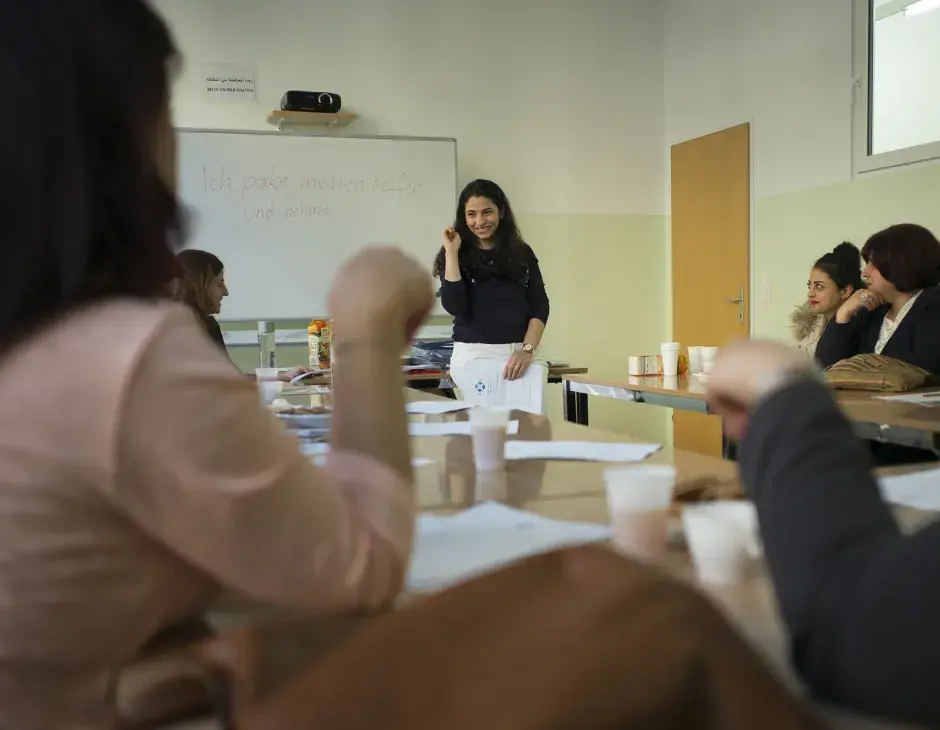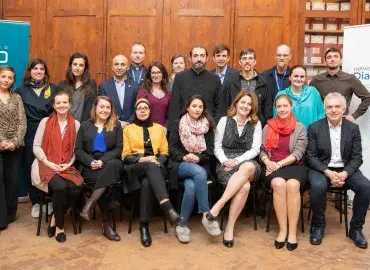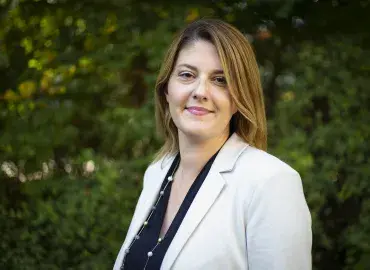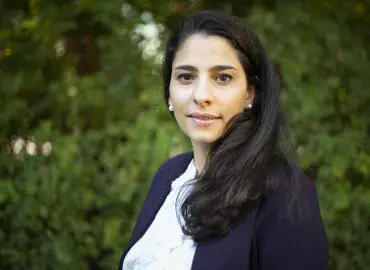In public discourse, religion is often seen as a limitation for integration, yet, academics and practitioners – some of whom have integrated themselves – feel that religion can benefit newly arrived people and their host communities. Below, members of the newly launched Network for Dialogue share their views on the relationship between religion, interreligious dialogue and integration, as well as its benefits and challenges
Ruham Al-Bezra is a KAICIID dialogue Facilitator who migrated to Vienna from Syria in 1999. She worked as an interpreter for the Austrian municipal authorities and taught integration-related courses, and since 2017, has been leading an 8-week integration workshop for newly arrived women. From her personal and professional experience, she finds that religion can either help or hinder the integration process – it always depends on the person. “For me, coming from a Muslim background, religion was not a problem,” she explains. “In fact, religion helped me to integrate, because in every aspect of our religion it is necessary to be integrated, while at the same time you have to keep your identity”.
Mabrouka Rayachi, KAICIID Fellow and Supervisor for Islamic Religious Teachers in Lower Austria, agrees. “It depends on how you conceive religion. If we have an open understanding of our religion, it will help us promote integration, but if we have a conservative understanding, it will be an obstacle to the integration process”. While Mabrouka has observed scepticism in parents who feel they have to protect their families and their religious views, she more often encounters parents who find encouragement to integrate in their religion.
For Dr. Angela María Arbeláez, founder of Art Bridges, an organization offering support through music and art education, religion and integration cannot be separated. “They go together. We are who we are because of our faith, and if there is no knowledge of the Other’s tradition, religion and culture, there is no integration”.
The importance of religion in the integration progress seems to be clear, but it has been often ignored in research and policy making, says Dr. Aleksandra Djurić Milovanović, KAICIID Fellow and Research Fellow at the Institute for Balkan Studies of the Serbian Academy of Sciences and Arts. “The link between religion, religious affiliation and their role in the migration crisis is quite neglected”. Dr. Erin Wilson, Associate Professor of Politics and Religion at the Faculty of Theology and Religious Studies of the University of Groningen, adds: “Religion is something that we often haven’t considered in the integration process. We are trying to catch up on that now, but there is the risk of putting too much emphasis on it. We have to be careful not to ignore it but also not to make too much of it”.
For the same reason, in practice, Al-Bezra does not start her workshops with religion in integration, but if the topic comes up, she addresses it from a religious, and sometimes personal perspective: “Religion itself is not the problem because integration does not start with religion and religion does not stop the integration process,” says Al-Bezra. Rayachi adds, “Religion itself is something abstract. What we make from our perception of religion is what counts”. They both believe that religion is not what determines if someone integrates or not.
Wilson cites concrete examples, “For a lot of people, religion provides support in the integration process, provides a community to immediately connect with, to ask about where to go for groceries, these kind of things. There are many examples of organizations that offer these kinds of support services. The risk that can arise from people seeking help from within their own religious community is that they then just stay within that community and don’t connect with broader society. It depends very much on the make-up of the religious community. Context is everything”. She also mentions how local communities’ assumptions, prejudices and apprehension toward religion can also hinder the integration process, which becomes more complex when local communities don’t understand or fear newcomers and their religion.
Religion has to be considered in the integration process, but should be neither at the centre of the discussion nor of policymaking. Wilson cites the case of Canadian authorities that identified towns and villages with mosques as appropriate places to send newly arrived refugees from Syria. “Whether a town has a mosque is not necessarily the most important thing for someone to integrate successfully into a community. It can help, but it shouldn’t be the main category for everyone,” said Watson.
Integration can only be successful when both newcomers and local communities to learn about one another and adapt to each other. “One of the challenges when we are looking at integration processes is that religion needs to be part of that mix,” Wilson adds. “But it needs to be part of that mix for everybody. Most of the time the expectation is placed on the people arriving, saying ‘Well, you have to adapt to our lifestyle’, but there is also a need for host communities to adapt as well”.
Religion, a safe place
Based in Lesbos, Greece, Dr. Angela María Arbeláez has witnessed first-hand how after a long journey, young migrants often reach Europe with only their mobile phones, documents and religion. “Religion is the only thing they kept from home,” she says. “They lost everything, but they kept their religion and beliefs, and these come with traditions and cultures”.
Rayachi agrees that religion plays an important role in the lives of many people who are seeking refuge in Europe: “At the beginning, refugees might view their religion as the only thing that gives them security, in that it defines who they are. It becomes an identity issue.” And while she has seen from her own personal experience how perception of religion changes through time, she warns “this doesn’t happen from one day to another and cannot be imposed.”
Because of her own religion and dialogue expertise, Rayachi often finds herself mediating between the parents and the school. “For example, in Ramadan if students have to fast and it becomes a concern because it is too hot, the headmaster cannot convince them to eat and drink, but the religious teacher can. Religious teachers are building bridges between the parents and the school”. Other common situations include convincing parents to allow their daughters to participate in an excursion with their class. Given the importance of religion in some parents’ lives, having a religious teacher explaining how the system works is of great value. “Parents trust and respect them, and sometimes it is enough for them to see a teacher’s headscarf to feel ‘she is one of us’ ”.
Al-Bezra experienced similar situations when working at a school. And as a dialogue facilitator, she often allows the dialogue about everyday situations to go in the direction that can support integration. “When I say I am a Muslim and my kids and I practice our religion, this gives hope and motivation to the newcomers. It tells that you can be integrated even if you have a different culture and religion,” she states. She usually recalls how she could still have fun going out with locals without drinking alcohol and without being perceived as a stranger. “Some Christian Austrians also go out and don’t drink alcohol. Integration is about people living together in harmony and respecting each other’s way of life.”
Religious communities, a unique support
Serbia became part of the Balkan Route to Europe in 2011, and in the peak of the migration crisis in 2015, faith-based organisations began to provide support to the newcomers, according to Djuric. Through her research, she found that “faith-based organizations have a crucial role in providing instant help”. Unlike other humanitarian organizations, these organizations’ efforts are initiated by the religious communities themselves, and given their structures, they have instant access to resources gathered by the community without investing time in designing projects or dealing with bureaucratic processes, she explains.
According to Djuric, shared values among religious people are also a strong motivation to help. “Solidarity is the key. Openness that comes from religion is very much specific to religious communities. The values of helping the Other, welcoming the stranger, are theologically present among them. This makes a huge difference”.
Wilson’s research in Australia led her to similar conclusions. When she asked members of Christian religious communities if they found it challenging to offer support to Muslim migrants, they answered ‘no’, as they believed the religious background was actually helping them. “Often we have more in common with them than secular organizations working in this sector. Even if our beliefs are different, we believe in something, we share ideas about the importance of family and the importance of God in our lives, and we are able to talk about these issues in a way that someone coming from a secular background or an atheist wouldn’t be able to engage with,” they told her.
Transformative dialogue
Academics and practitioners agree on the importance of interreligious dialogue in the context of integration. When newcomers and local communities learn about each other’s religions, they are establishing firm foundations for peaceful coexistence. However, not any conversation among believers can count towards this goal, Rayachi explains: “Interreligious dialogue has to be authentic; it has to dig deeper than the surface and should be accompanied by critical thinking to make it a real dialogue. When dialogue digs deeper, the quality is higher and it can contribute to integration”.
In Arbeláez’ experience, beginning with intercultural dialogue before reaching interreligious dialogue has been a successful methodology. Creative initiatives involving art, music or food, have allowed participants in her activities to better know and understand each other. From Wilson’s research in Indonesia, she found that another successful approach is when people from different religious backgrounds come together to work on community issues, rather than explicitly for the purpose of interreligious dialogue.
Finally, while interreligious dialogue can contribute to integration, situations involving migration can also initiate interreligious dialogue, Djurić has found. “Sometimes people did not know each other, did not collaborate. But now after doing something that goes beyond their own religious differences and national or ethnic boundaries, interreligious dialogue begins to work without being forced. It spontaneously starts to be a unifying force in response to some difficulties that communities are facing”.
Click on the links below to read the full interviews with:
Dr. Aleksandra Djurić Milovanović
Newly launched “Network for Dialogue” aims to support more effective integration policies in Europe
…
Dr. Aleksandra Djurić Milovanović is a graduate of the KAICIID Fellows programme and Research…
Ruham Al-Bezra is a KAICIID Dialogue Facilitator
From your experience, how do you think religion can…





